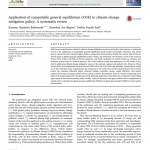
|
|Application of Computable General Equilibrium to Climate Change Mitigation Policy: A Systematic Review.With the growing literature related to climate change mitigation measures and policy interventions, a systematic review of the application of computable general equilibrium (CGE) model is inevitable. Therefore, this article aims to characterise the relevant studies, define a comparative framework to identify the current state-of-the-art and the gaps in applied general equilibrium models. Category: Climate-Informed Fiscal Planning, Climate-Resilient Financial Sector, Align Policies with Paris Agreement |
| |
|Disaster Risk Management and Fiscal Policy: Entry Points for Finance Ministries.This chapter reflects on the benefits of disaster risk management (DRM) in the context of fiscal policy and public investment. Of particular interest is the question of how those in charge of fiscal policy decisions can recognise and realise the economic and broader benefits of DRM. We consider the interplay between public DRM investment and fiscal policy and provide an overview of current debate as well as assessment methods, tools and policy options. Category: Climate-Informed Fiscal Planning |
| |
|Current Climate Models Are Grossly Misleading.Nicholas Stern calls on scientists, engineers and economists to help policymakers by better modelling the immense risks to future generations, and the potential for action. Category: Climate-Informed Fiscal Planning |
| |
IEA |Good Practice Policy Framework for Energy Technology Research, Development and Demonstration (RD&D).Accelerating Energy Innovation (AEI) is a new project being launched by the International Energy Agency (IEA). Category: Climate-Informed Fiscal Planning, Align Policies with Paris Agreement |
| |
Others |A Preliminary Review of the American Recovery and Reinvestment Act’s Clean Energy PackageThe American Recovery and Reinvestment Act included more than $90 billion in strategic clean energy investments intended to promote job creation and promote deployment of low-carbon technologies. In terms of spending, the clean energy package has been described as the nation’s “biggest energy bill in history.” To provide a preliminary assessment of the Recovery Act’s clean energy package, this paper reviews the rationale, design, and implementation of the act. Category: Promote Carbon Pricing Measures, Climate-Informed Fiscal Planning, Align Policies with Paris Agreement, NDC Support and Implementation |
5 results found